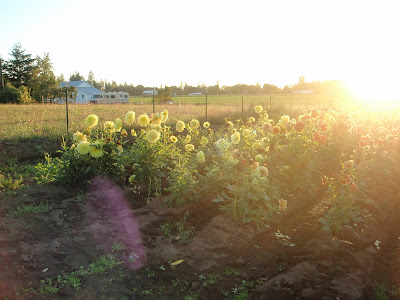We left on Friday at 5 AM, which wasn't hard for either of us, as we are both early risers. We arrived in Canby at the fairgrounds shortly after 8 AM, including a couple of stops for bathroom breaks and coffee.
We signed in for our classes (I took a lace spinning class in the morning, and a sock spinning class in the afternoon, and Jen took a Navajo spindling class), and wandered around for 30 minutes before going to our respective classes.
Rejoining for lunch, we compared notes. Jen discovered she didn't really enjoy Navajo spindling, but was glad she took a class to confirm that suspicion. I picked up several tricks for lace spinning - mainly the tenet of "overspin, underply". My teacher, Sheila January, also showed us how to spin cobweb laceweight yarn - that is, yarn that, at 2 ply, would be about the grist of sewing thread. She told us how a teacher of hers spun yarn for Orenburg shawls, and gave her about 2 oz, if that, of ultrafine Merino locks, and told her it would be enough for a 6 foot diameter Orenburg shawl.
We also got to spin a variety of fibers for each class. For the lace class, Sheila gave us some superwash Merino, then followed that with silk brick, then a Merino / yak blend (70/30?), and finally we tried our hand at cobweb spinning using some BFL locks. I was pleased to learn it is possible, though it is a technique I do not see myself using, except as a means to keep myself sharp and able to spin a variety of yarns.
After lunch, I went back to Sheila's room for the sock class (turns out she taught both classes!), while Jen amused herself by wandering and knitting. In this class, the main thing I came away with was to spin firmly for sock yarn, and that nylon as a strengthener is unnecessary, because all it does is make a skeleton to make darning holes easier. Natural alternatives for nylon in sock yarn include silk, mohair, or considering not using a fine wool to spin the yarn in the first place. In fact, one of the samples was Wensleydale top, and it made a great, firm 2 ply yarn for me! Other samples we used were a Shetland top that was quite lovely, a BFL top, a pin-drafted CVM which was lovely, and a Merino / alpaca blend.
 Some seedheads at sunset in a state park in Canby
Some seedheads at sunset in a state park in CanbyWhat did I buy? 3 oz Jacob top, two different Shetland preparations (one 4 oz ball of top, and 8 oz of Shetland prepared in two batts), 7 oz of BFL (the same preparation I spun in class), a skein of BMFA Laci, a skein of BMFA Socks That Rock Midweight (a Rare Gems color that reminds me of an aquatic rainbow), and two skeins of BMFA BFL Sport in "Jabberwocky", an autumnal rainbow colorway that enchanted me (and, at 600+ yards each, two skeins will knit me a fine sweater).
I thought I would share some photos of Canby itself, rather than the yarn I bought. You can see all that on my Ravelry stash page.
I thought I would share some photos of Canby itself, rather than the yarn I bought. You can see all that on my Ravelry stash page.
 Moonrise at the park
Moonrise at the parkI hate to have noticed this, but the demographics of a fiber festival are fairly predictable - mostly women, and probably 90% of those women are overweight. I don't know why. Maybe that is why I subconsciously chose to wear my Crossfit shirt on Friday.
 A dahlia farm
A dahlia farmOK, I suppose I should show a picture from the actual festival... excuse the lack of focus from the camera!
I can't wait for the 2010 class list and another trip with Jen! :)
I hope to post my sample pics up here soon...

















